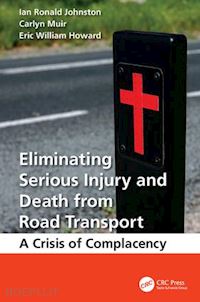Dr. Ian Ronald Johnston is a psychologist with a PhD in human factors. He has worked in the transport field, specialising in transport safety, for over 40 years. He worked in the Australian government’s inaugural road safety unit in the 1970s, headed the Victorian government’s road safety unit in the 1980s, was managing director of Australia’s premier transport research organisation in the 1990s, and was director of the world-renowned Monash University Accident Research Centre until his retirement (from full-time work) in 2006. Dr. Johnston now runs his own consultancy specialising in helping government and industry develop and implement safety strategies. He is also deputy chair of Australia’s National Transport Commission and a member of the Core Advisory Group of the World Bank’s Global Road Safety Facility. He was a member of Australia’s National Road Safety Council for the 3 years of its existence. Dr. Johnston has published extensively in the field and has received several awards for his work, ncluding being made a member of the Order of Australia in 1997.Dr. Carlyn Muir is a research fellow at the Monash Injury Research Institute, which incorporates the Monash University Accident Research Centre (MUARC). She is a psychologist whose doctoral research examined driver licensing policy for people following brain injury. She has been involved in the development and review of public health policy not only from a research perspective, but also through direct policy implementation within state health services. Dr. Muir’s current research involves the design and implementation of a range of injury prevention and public health projects, with a focus on community health and safety, policy, and evaluation. She has published journal articles, book chapters, and government reports across the community safety space.Since 2006 Eric William Howard has operated a strategic road safety consultancy that provides advisory services to clients including the World Bank, Global Road Safety Partnership, AusAID, PIARC, OECD/ITF, international NGOs, and overseas and Australian national and state governments and corporations. Howard was general manager of road safety for VicRoads, the lead role in the Victorian government, for 7 years. He was also a member of the Ministerial Road Safety Council and the National Road Safety Task Force following a career as a local government CEO and senior engineering manager for 24 years. His experience in public health includes 4 years as a board vice president of Mercy Hospital for Women, a leading teaching hospital in Melbourne. Howard chaired the OECD/ITF working group, which developed the “Towards Zero: Ambitious Targets and Safe System Approach” report, published in 2008; he was principal author for the United Nations Road Safety Collaboration–sponsored Speed Management Manual published in March 2008; and he was the independent chair of the Western Australian Parliamentarians’ Road Safety Reference Group from 2008 to 2011. He chairs a number of road safety task forces for the New South Wales government and he is co-chair of the 33,900—the Australian Road Safety Collaboration.











